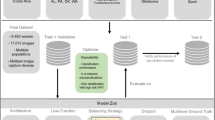Abstract
Automated visual evaluation (AVE) of uterine cervix images is a deep learning algorithm that aims to improve cervical pre-cancer screening in low or medium resource regions (LMRR). Image quality control is an important pre-step in the development and use of AVE. In our work, we use data retrospectively collected from different sources/providers for analysis. In addition to good images, the datasets include low-quality images, green-filter images, and post Lugol’s iodine images. The latter two are uncommon in VIA (visual inspection with acetic acid) and should be removed along with low-quality images. In this paper, we apply and compare two state-of-the-art deep learning networks to filter out those two types of cervix images after cervix detection. One of the deep learning networks is DeepSAD, a semi-supervised anomaly detection network, while the other is ResNeSt, an improved variant of the ResNet classification network. Specifically, we study and evaluate the algorithms on a highly unbalanced large dataset consisting of four subsets from different geographic regions acquired with different imaging device types. We also examine the cross-dataset performance of the algorithms. Both networks can achieve high performance (accuracy above 97% and F1 score above 94%) on the test set.
Access this chapter
Tax calculation will be finalised at checkout
Purchases are for personal use only
Similar content being viewed by others
References
Jeronimo, J., Schiffman, M.: Colposcopy at a crossroads. Am. J. Obstet. Gynecol. 195, 349–353 (2006)
Hu, L., et al.: An observational study of deep learning and automated evaluation of cervical images for cancer screening. J. Natl. Cancer Inst. 111, 923–932 (2019)
Xue, Z., et al.: A demonstration of automated visual evaluation of cervical images taken with a smartphone camera. Int. J. Cancer 147, 2416–2423 (2020)
Pal, A., et al.: Deep metric learning for cervical image classification. IEEE Access 9, 53266–53275 (2021). https://doi.org/10.1109/ACCESS.2021.3069346
Guo, P., et al.: Network visualization and pyramidal feature comparison for ablative treatability classification using digitized cervix images. J. Clin. Med. 10(5), 953 (2021). https://doi.org/10.3390/jcm10050953
Guo, P., et al.: Ensemble deep learning for cervix image selection toward improving reliability in automated cervical precancer screening. Diagnostics (Basel, Switz.) 10(7), 451 (2020). https://doi.org/10.3390/diagnostics10070451
Guo, P., Xue, Z., Long, L.R., Antani, S.: Deep learning for assessing image focus for automated cervical cancer screening. In: Proceedings of the IEEE International Conference on Biomedical and Health Informatics, Chicago, IL, USA, 19–22 May 2019 (2019)
Digiovanni, S.L., Guaragnella, C., Rizzi, M., Falagario, M.: Healthcare system: a digital green filter for smart health early cervical cancer diagnosis. In: IEEE 2nd International Forum on Research and Technologies for Society and Industry Leveraging a better tomorrow (RTSI), Bologna, Italy, pp. 1–6 (2016). https://doi.org/10.1109/RTSI.2016.7740564
Sellors, J.W., Sankaranarayanan, R. (eds.): An introduction to colposcopy: indications for colposcopy, instrumentation, principles and documentation of results. Colposcopy and treatment of cervical intraepithelial neoplasia: a beginners’ manual. https://screening.iarc.fr/colpochap.php?lang=1&chap=4
Yue, Z., et al.: Automatic CIN grades prediction of sequential cervigram image using LSTM with multistate CNN features. IEEE J. Biomed. Health Inform. 24(3), 844–854 (2020). https://doi.org/10.1109/JBHI.2019.2922682
Desai, K.T., et al.: Design and feasibility of a novel program of cervical screening in Nigeria: self-sampled HPV testing paired with visual triage. Infect. Agents Cancer 15, 60 (2020). https://doi.org/10.1186/s13027-020-00324-5
Lin, T., Goyal, P., Girshick, R., He, K., Dollár, P.: Focal loss for dense object detection. In: 2017 IEEE International Conference on Computer Vision (ICCV), Venice, Italy, pp. 2999–3007 (2017). https://doi.org/10.1109/ICCV.2017.324
Chalapathy, R., Chawla, S.: Deep learning for anomaly detection: a survey. https://arxiv.org/abs/1901.03407
Ruff, L., et al.: Deep semi-supervised anomaly detection. In: The International Conference on Learning Representations (ICLR) (2020)
Ruff, L., et al.: Deep one-class classification. In: Proceedings of the 35th International Conference on Machine Learning, PMLR, vol. 80, pp. 4393–4402 (2018)
Zhang, H., et al.: ResNeSt: split-attention networks. https://arxiv.org/abs/2004.08955
Xie, S., Girshick, R., Dollár, P., Tu, Z., He, K.: Aggregated residual transformations for deep neural networks. https://arxiv.org/abs/1611.05431
Acknowledgement
This research was supported by the Intramural Research Programs of the National Library of Medicine (NLM) and the National Cancer Institute (NCI), both part of the National Institutes of Health.
Author information
Authors and Affiliations
Corresponding author
Editor information
Editors and Affiliations
Rights and permissions
Copyright information
© 2022 This is a U.S. government work and not under copyright protection in the U.S.; foreign copyright protection may apply
About this paper
Cite this paper
Xue, Z. et al. (2022). Cleaning Highly Unbalanced Multisource Image Dataset for Quality Control in Cervical Precancer Screening. In: Santosh, K., Hegadi, R., Pal, U. (eds) Recent Trends in Image Processing and Pattern Recognition. RTIP2R 2021. Communications in Computer and Information Science, vol 1576. Springer, Cham. https://doi.org/10.1007/978-3-031-07005-1_1
Download citation
DOI: https://doi.org/10.1007/978-3-031-07005-1_1
Published:
Publisher Name: Springer, Cham
Print ISBN: 978-3-031-07004-4
Online ISBN: 978-3-031-07005-1
eBook Packages: Computer ScienceComputer Science (R0)




